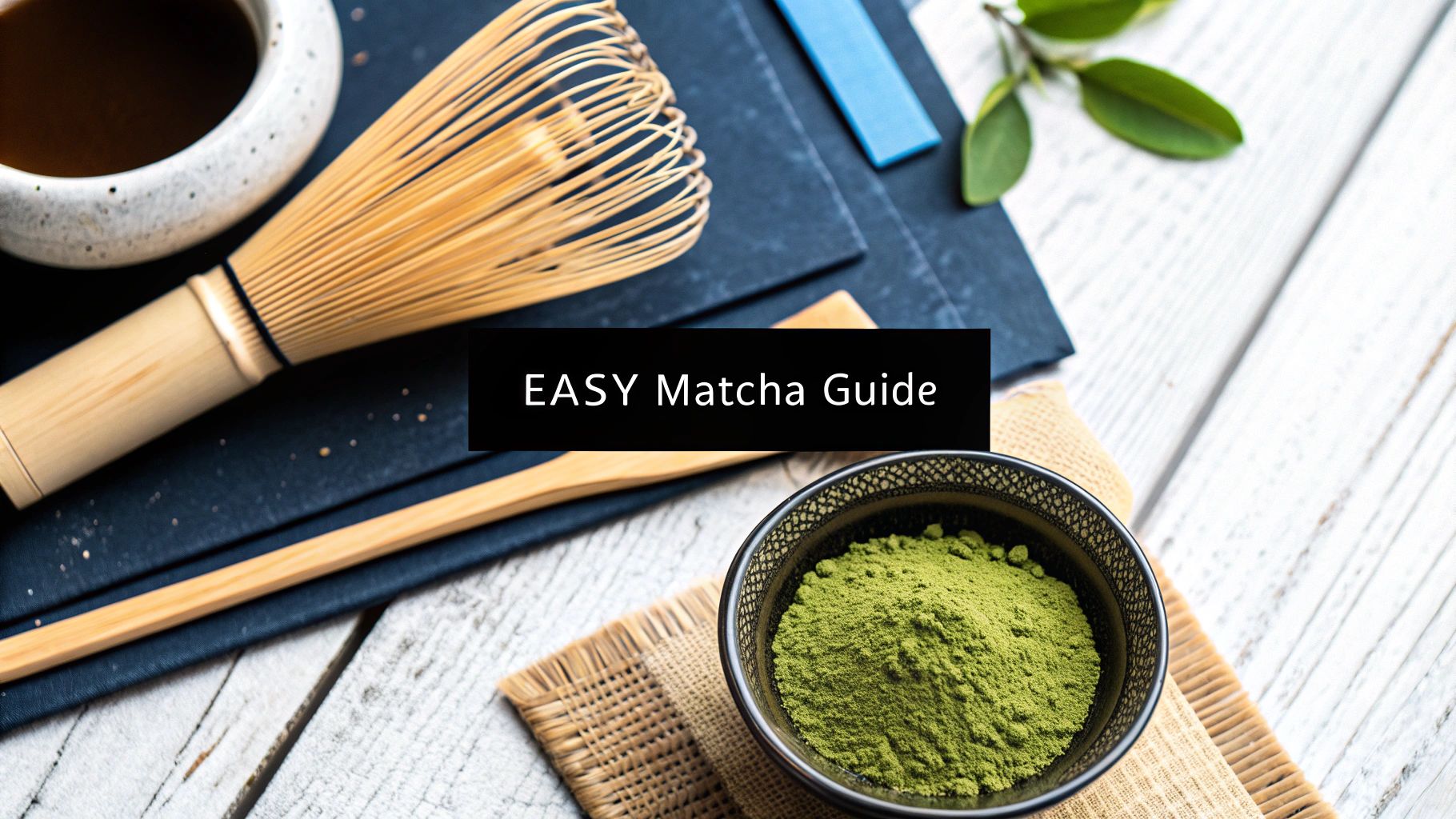Making authentic matcha is a simple, mindful ritual. At its core, you're just whisking sifted matcha powder with hot water until it’s beautifully frothy. The real magic, though, is in the details—the right tools, the perfect ratios, and a bit of technique. Nailing these fundamentals is the key to creating that vibrant, smooth, and delicious cup every single time. Let's walk through those first essential steps to make sure your initial experience with Amatsu Matcha is a brilliant one.
Your First Step to the Perfect Cup
Learning to make matcha is less about a complex recipe and more about embracing a process. It’s a moment to slow down and connect with what you're doing, transforming that fine, bright green powder into something truly nourishing. The ritual itself is just as rewarding as the drink. So, forget any notion that it's difficult; a perfect cup is well within your reach.
The biggest secret to avoiding that dreaded bitterness? It all comes down to controlling a few key things: the quality of your matcha, the temperature of your water, and your whisking action. These are the three pillars of a great cup. For example, if you pour boiling water over the delicate tea powder, you'll scorch it instantly, resulting in a harsh, unpleasant flavour. It’s the most common mistake and, thankfully, the easiest to fix.
The Core Principles of Matcha Preparation
Great matcha really boils down to three simple actions: sifting the powder to get rid of clumps, using water that’s just the right temperature (around 70-80°C), and whisking vigorously to create a lovely layer of foam. This aeration isn't just for looks; it completely changes the texture and taste, giving you a much smoother, creamier drink. When you see that delicate foam form on top, you know you’ve nailed it.
A well-made matcha is a balance of art and science. By respecting the core principles of temperature and technique, you honour a centuries-old tradition and unlock the tea's true, vibrant flavour profile.
Getting these elements right from the start makes a world of difference, helping you create a café-quality drink right in your own kitchen. It's the perfect foundation for exploring different blends, like our energising Pure blend from Amatsu Matcha, which is absolutely ideal for this traditional preparation.
Matcha Preparation at a Glance
To make things even clearer, here's a quick reference guide. Think of this as your cheat sheet for the essential elements of a perfect cup of matcha.
| Component | Ideal Specification | Why It Matters |
|---|---|---|
| Matcha Quality | Ceremonial Grade (e.g., Amatsu Pure) | Ensures a smooth, non-bitter taste and vibrant colour. Culinary grade is better for lattes or baking. |
| Water Temperature | 70-80°C (160-175°F) | Prevents scorching the tea leaves, which is the primary cause of bitterness. |
| Matcha-to-Water Ratio | 2g Matcha to 60-80ml Water | Creates a balanced flavour. Too much powder can make it overpowering; too little makes it weak. |
| Sifting | Sift powder before adding water | Removes clumps, ensuring the matcha dissolves completely for a smooth, even texture. |
| Whisking Motion | Rapid 'W' or 'M' pattern | Aerates the tea to create a creamy layer of fine foam, which enhances flavour and mouthfeel. |
Keep these points in mind, and you'll be well on your way to mastering the art of matcha. It's all about practice and finding what works best for you.
Getting Your Matcha Tools Together
Before you can think about how to make matcha, let's talk about the gear. While you can make a passable cup with what you have in your kitchen, using the traditional tools elevates the process into a mindful ritual and honestly, it makes for a much better final product. It’s the real secret behind getting that perfect cup.
Think of these tools less as strict requirements and more as specialised instruments, each designed to bring out the very best qualities of your matcha. They each play a part in creating that smooth texture and rich, vibrant flavour we’re all after.
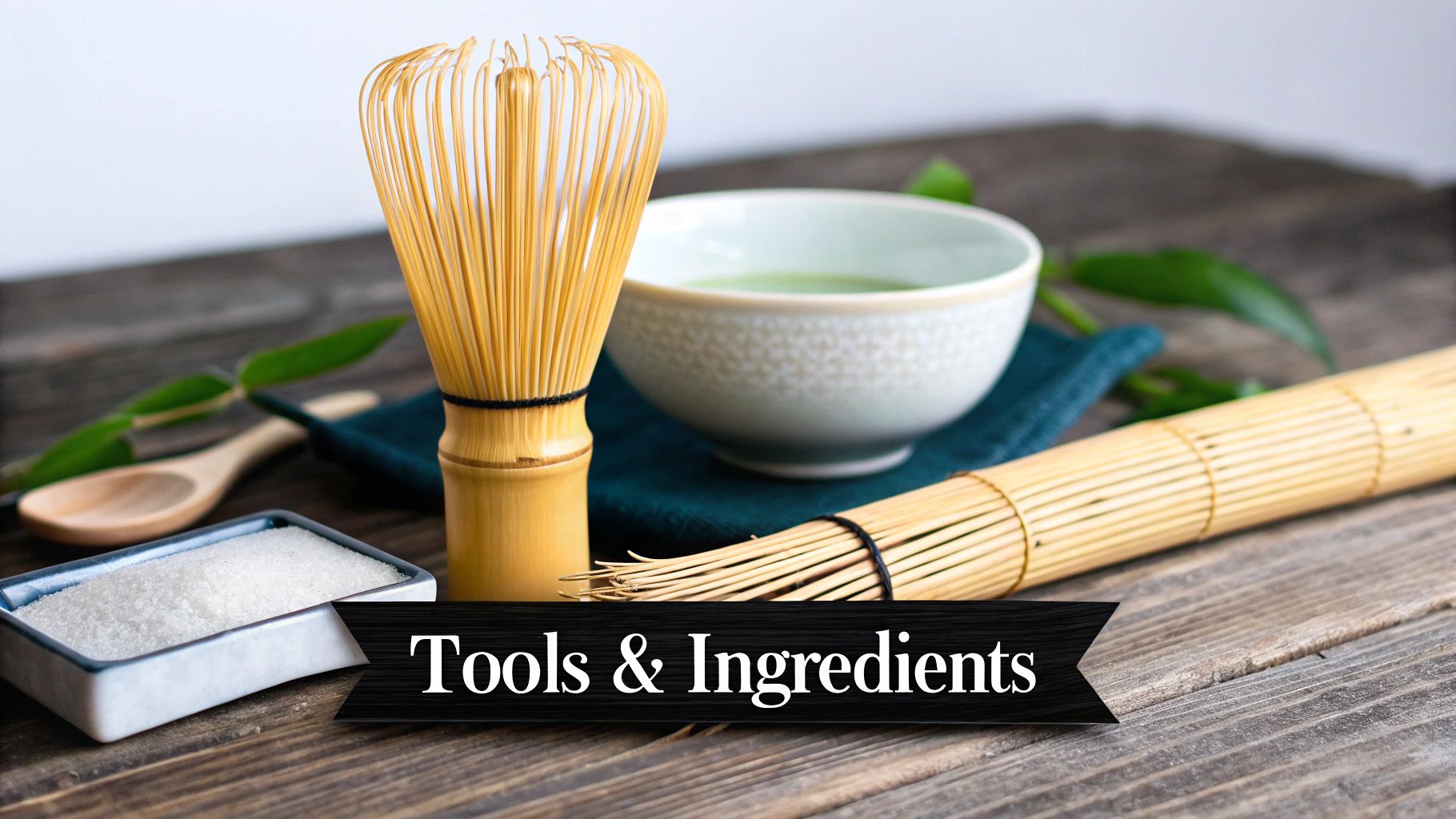
The Bamboo Whisk (Chasen)
If there's one tool you really shouldn't skip, it's this one. The chasen, or bamboo whisk, is a beautifully crafted utensil, typically with over 100 flexible tines carved from a single piece of bamboo. These delicate prongs are absolutely essential for properly suspending the matcha powder in the water, breaking down any clumps, and whipping up a gorgeous layer of stable microfoam.
You might be tempted to use a metal kitchen whisk, but it's far too harsh and won't create that lovely froth. An electric frother can get you close, but it tends to create large, unstable bubbles that vanish in seconds. The chasen, on the other hand, is perfectly designed for aeration, giving your matcha its signature creamy mouthfeel. You don't need a top-of-the-line one to start, but a decent quality chasen is an investment you won't regret.
The Matcha Bowl (Chawan)
Next up is the chawan, or matcha bowl. Its wide, flat-bottomed shape is about function just as much as form. The design is intentional, providing the perfect space for you to whisk effectively. That broad base gives you plenty of room to move the chasen back and forth in that crucial 'W' or 'M' motion without splashing matcha all over your countertop.
Anyone who's tried whisking in a regular coffee mug knows how frustrating and messy it can be. A proper chawan allows the chasen’s tines to stay in full contact with the bottom of the bowl, ensuring every last bit of powder gets mixed in properly. Once you've used one, you'll realise just how much easier it makes achieving that perfect, frothy consistency.
Using the right tools honours the tradition, but it also just makes the technique so much easier. A good chawan and chasen work in harmony to make sure the powder dissolves completely, giving you a smooth, vibrant, and perfectly frothed tea every single time.
The Scoop, Sifter, and a Few Workarounds
Finally, there are two smaller items that play a surprisingly big role:
- The Chashaku: This is a simple, elegant bamboo scoop specifically for measuring matcha powder. A level chashaku scoop holds about one gram, so two scoops are generally perfect for a standard serving.
- The Sifter: Matcha powder is incredibly fine, which means it clumps together easily thanks to static electricity. Pushing it through a small, fine-mesh sieve before adding your water is a non-negotiable step if you want a silky-smooth, lump-free drink.
Now, if you're just starting out and don't have these on hand, don't worry. You can absolutely improvise. A standard teaspoon can stand in for the chashaku (1/2 to 1 level teaspoon is a good equivalent), and any small tea strainer will do the job as a sifter.
The most important thing is to make sure your powder is fine and measured correctly. This is especially true when you’re working with a high-quality organic matcha from Japan, as you'll want to do everything you can to coax out its best possible flavour.
Perfecting Your Water and Ratios
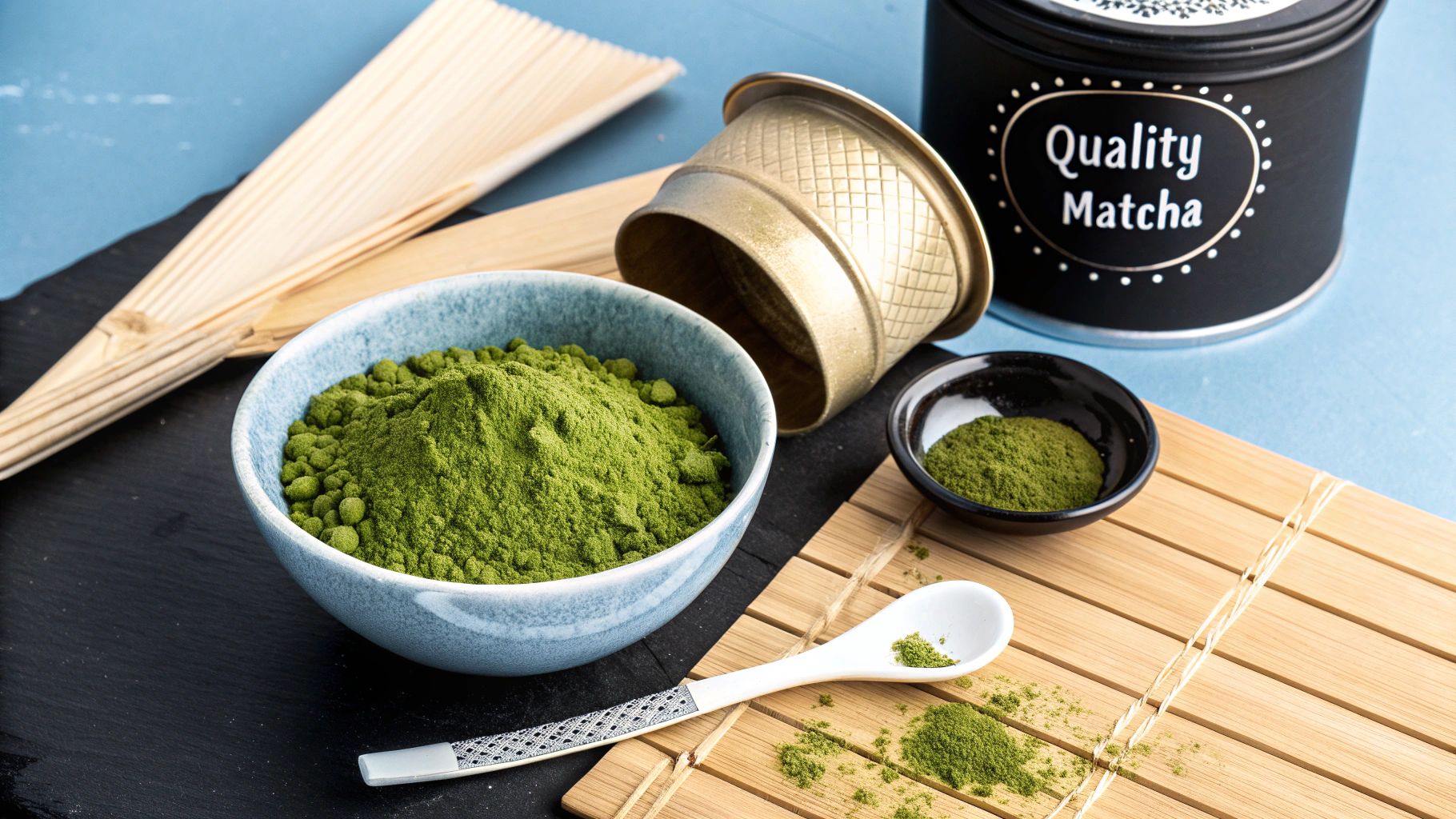
If your matcha tastes bitter, the culprit is almost always one of two things: your water is too hot, or your matcha-to-water ratio is off. Getting these two details right is the single most important step in unlocking the smooth, rich flavour of a quality tea. It truly is the difference between a harsh, disappointing brew and a sublime experience.
First, let's talk temperature. Pouring boiling water directly onto your delicate matcha powder will scorch it. This instantly releases tannins that create a sharp, astringent taste, and it's probably the most common mistake people make when they first start out.
The sweet spot for water temperature is between 70-80°C (160-175°F). You don't need a fancy temperature-controlled kettle for this. Just boil your water and let it sit for three to four minutes before pouring. Another easy trick is to pour the boiled water into a separate cup first to help it cool down much faster.
Finding Your Perfect Matcha Ratio
Once your water is at the right temperature, it's time to measure your matcha. The correct ratio is key to achieving a balanced flavour profile. Too much powder can taste overwhelmingly strong and earthy, while too little results in a weak, watery drink.
For a traditional usucha (thin tea), the standard starting point is:
- 2 grams of matcha powder (about one level teaspoon, or two chashaku scoops)
- 60-80ml of water (roughly 1/3 of a standard mug)
This ratio provides a perfect balance, allowing the complex umami and sweet notes of a ceremonial-grade matcha to shine. However, think of this as just a starting point. Don't be afraid to adjust these amounts to suit your personal preference. If you enjoy a stronger, more robust flavour, try using slightly more matcha or a little less water.
The beauty of the matcha ritual is its adaptability. Start with the traditional ratio, but feel free to experiment. You might find that a slightly stronger concentration is your perfect morning energiser.
The rising popularity of matcha in the UK really speaks to this versatility. The market is projected to grow from around USD 137.25 million in 2025 to USD 517.96 million by 2035, largely because people are finding new and personal ways to enjoy it, from traditional teas to lattes and functional foods. With the powder form making up over 55% of the market, mastering this basic preparation is a great skill to have.
Once you have your measurements sorted, you're ready for the most active part of the process. If you're still refining your technique, our comprehensive guide on how to prepare matcha tea offers additional tips to help you master every step.
Mastering the Art of Whisking
This is where the real magic happens. You've got your tools, the water is at the perfect temperature, and your powder is measured out. Now comes the whisking – the final, and most crucial, skill that defines the taste and texture of your matcha. It's what separates a clumpy, bitter drink from a smooth, vibrant one crowned with a beautiful layer of foam.
The secret is all in the motion. Don't think of it like stirring coffee; moving the whisk in circles just pushes the powder around. The real goal is to aerate the tea, whipping air into the liquid to create that rich, creamy froth. It all comes down to a rapid, wrist-driven movement.
To get started, hold your bamboo whisk, or chasen, correctly. This gives you maximum control and prevents your hand from getting tired. Grip it lightly from the top, almost like you'd hold a pencil, using just your thumb and index finger. Keep your wrist relaxed and flexible, because all the power comes from a quick flicking motion, not from your whole arm.
The Correct Whisking Motion
The proper technique isn't circular, but a swift, zig-zag pattern. Imagine you’re drawing a sharp ‘W’ or ‘M’ shape back and forth across the bottom of the bowl. This rapid movement is what suspends the fine tea particles evenly throughout the water and whips up that signature layer of delicate foam.
Start slowly for the first few seconds. This helps break up any tiny clumps that survived the sifter and creates a smooth paste. Once you see the powder is fully mixed in, pick up the pace. You should hear a light, scratchy sound as the whisk tines brush against the ceramic bowl – that’s a good sign!
The quality of your foam is a direct reflection of your technique. You're aiming for a blanket of tiny, uniform bubbles, much like the crema on a good espresso. If you see large, soapy-looking bubbles, it probably means you're whisking a bit too slowly or not sticking to that zig-zag motion.
Keep up this rapid 'W' pattern for about 20-30 seconds. You'll know you're done when a thick, frothy layer forms on the surface. To finish, slow down your whisking and gently lift the chasen from the centre of the bowl. This little move helps the foam settle into a smooth, even surface. Visualising the initial preparation, as shown below, can be a great help before you even start whisking.
This image shows the foundational steps of measuring and sifting, which set the stage for a perfect whisk.
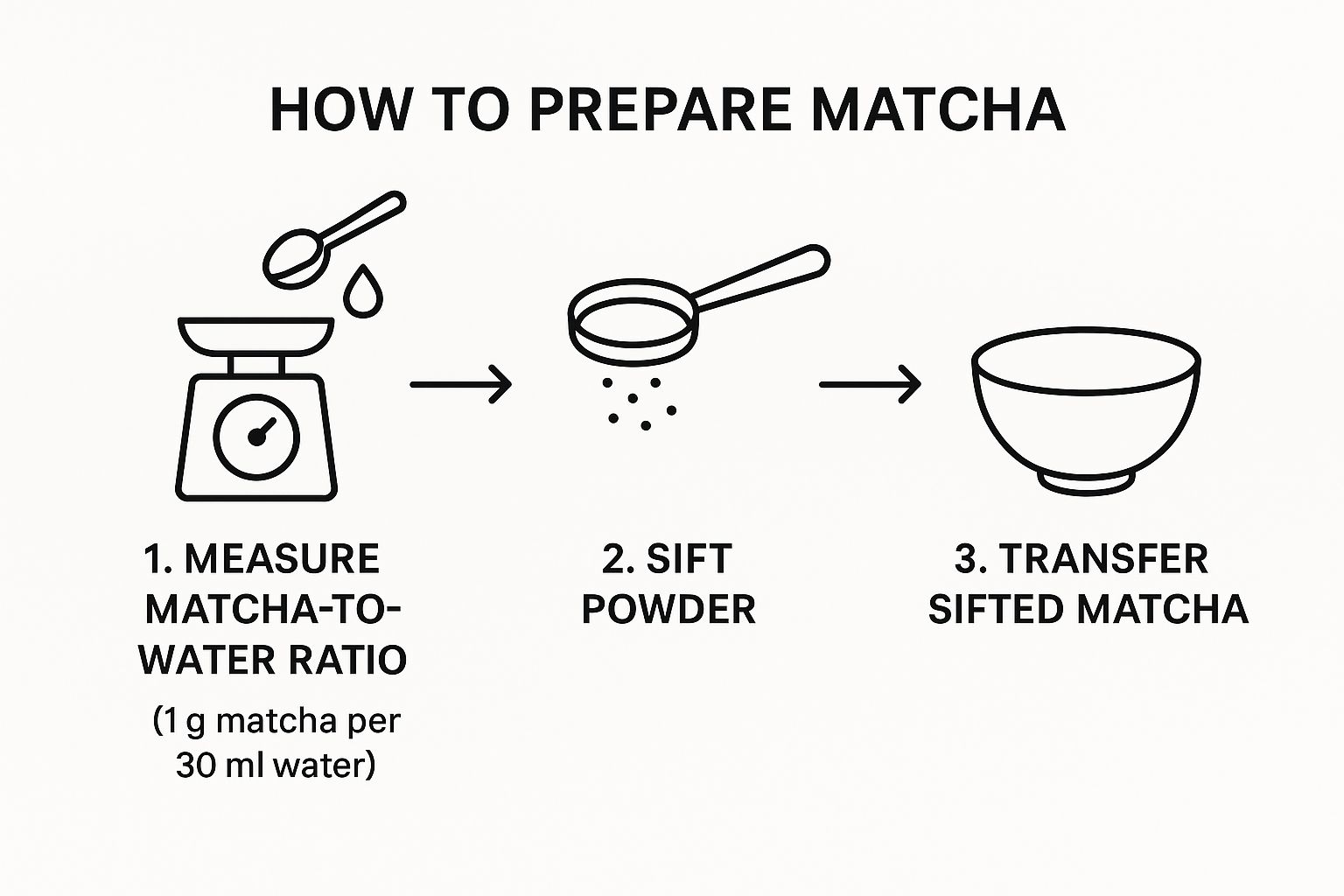
Following this sequence makes sure your matcha powder is perfectly prepped, which is absolutely essential for getting a lump-free and frothy result.
Common Mistakes to Avoid
Even with the right motion in mind, a few common slip-ups can get in the way of a perfect bowl. Learning to spot them will dramatically improve your matcha.
- Pressing Too Hard: Don't mash the chasen into the bottom of the bowl. This can damage the delicate bamboo tines and actually slows you down, preventing you from creating a good froth. Let it glide lightly across the surface.
- Using Your Whole Arm: Remember, the power comes from a flick of the wrist, not a big movement from your shoulder or elbow. This keeps the motion fast, efficient, and controlled.
- Whisking in a Circle: This is the mistake I see most often. A circular stir just swirls the powder around; it doesn’t incorporate the air needed for a good froth. Always stick to that sharp 'W' or 'M' pattern.
It takes a bit of practice to get the feel for it, but mastering this technique is an incredibly rewarding part of the matcha ritual. For a closer look at the unique tool that makes it all happen, check out our guide on the matcha green tea bamboo whisk and what makes it so special.
Creative Ways to Enjoy Your Matcha
Once you’ve mastered the mindful ritual of a traditional bowl of matcha, a whole new world of possibilities opens up. The journey doesn't stop with a perfectly whisked tea; it can lead to creamy lattes, vibrant smoothies, and functional drinks that genuinely enhance your day. Learning to adapt your matcha preparation means you can tailor its incredible benefits to whatever your lifestyle demands.
This flexibility is a massive part of its growing appeal. It's no surprise that the UK matcha tea market is booming, with a projected growth rate of 8.3% annually between 2025 and 2030. This isn't just a trend; it's a shift towards nutrient-packed drinks that support mental clarity and wellbeing, making matcha a staple in fitness and mindfulness practices everywhere. You can read more about the UK's growing love for matcha on Grandview Research.
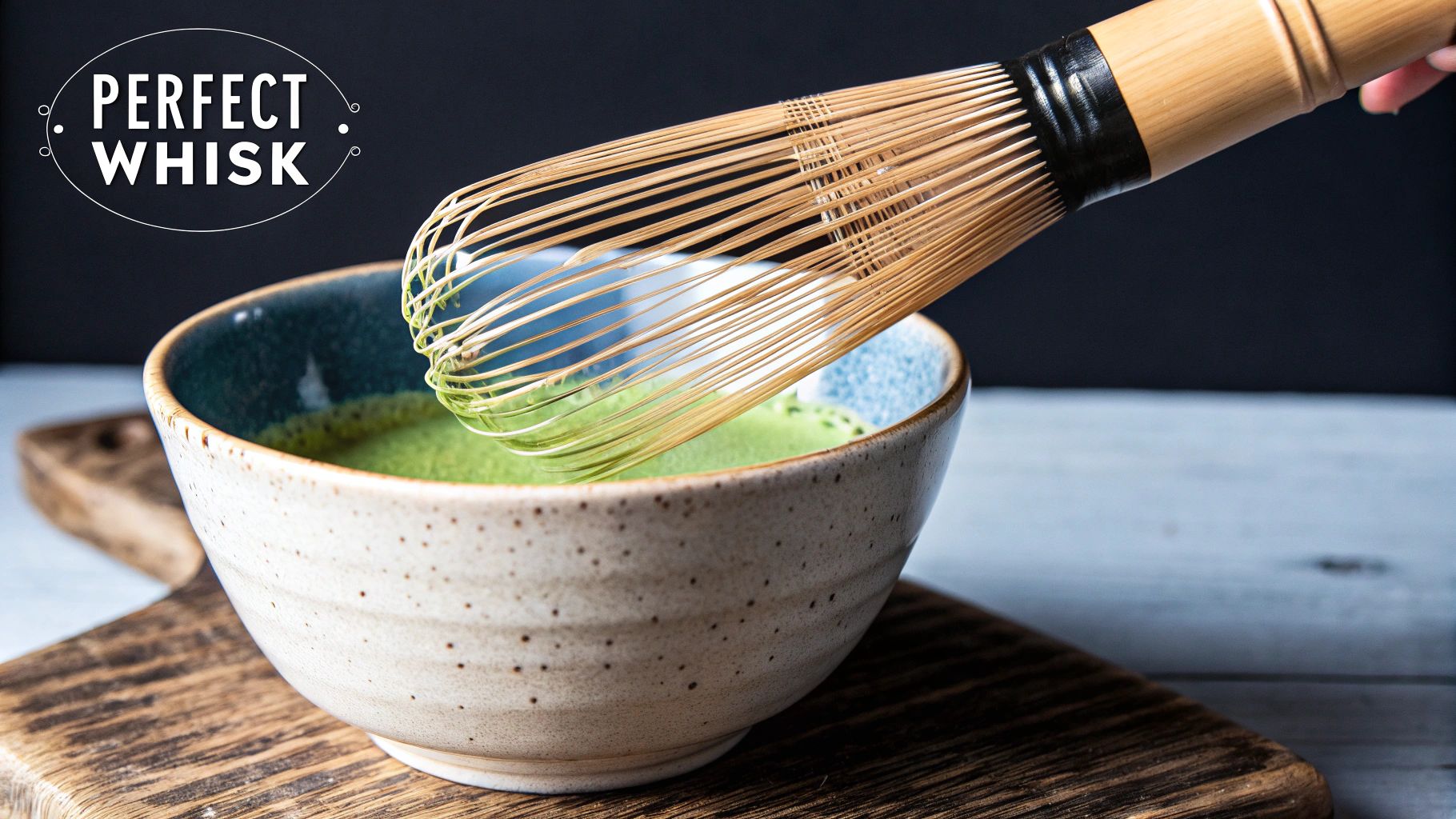
The Ever-Popular Matcha Latte
A creamy matcha latte is easily one of the most loved ways to drink matcha. If you find the earthy flavour of traditional tea a little intense at first, a latte is the perfect introduction. Plus, it’s surprisingly easy to whip up a café-quality version right in your own kitchen, whether you prefer it hot and comforting or poured over ice for a refreshing lift.
You’ll start just as you would for a traditional tea: sift about one teaspoon of matcha into your bowl, add a little hot water (remember, not boiling!), and whisk until it's a smooth, vibrant paste. But here’s the twist—instead of more water, you'll pour in around 200ml of steamed milk. Oat, almond, and dairy all work beautifully, so pick your favourite. For a more detailed walkthrough, don’t miss our complete guide on how to make a matcha latte.
Supercharge Your Routine With Functional Blends
Going beyond the latte, matcha makes a brilliant base for functional drinks designed to hit specific wellness goals. This is where Amatsu’s unique blends really come into their own, pairing the potency of ceremonial-grade matcha with carefully chosen, high-impact ingredients.
Here are a few ways to upgrade your daily routine:
-
For Morning Focus: Start your day with our Shrooms blend. After whisking it with hot water, add a splash of oat milk and a teaspoon of MCT oil. The combination of Lion's Mane and Cordyceps mushrooms with matcha's L-theanine gives you a clear head and sustained focus, completely avoiding the jitters you get from coffee.
-
For Pre-Workout Energy: Before a workout, shake up a serving of our Strength blend with cold water and a good squeeze of fresh lemon. The added creatine gives your muscles a real boost, while the matcha provides that clean, steady energy to carry you through the entire session.
-
For a Beauty-Boosting Smoothie: Blend a serving of Radiance with a frozen banana, a handful of spinach, almond milk, and a scoop of vanilla protein powder. The marine collagen supports your skin and hair from the inside out, turning a simple smoothie into something truly nourishing.
Exploring these creative recipes turns your matcha ritual from a simple cup of tea into a versatile toolkit for everyday wellness. Each blend offers a new way to tap into its benefits, perfectly suited to what your body needs at that moment.
Common Matcha Questions Answered
https://www.youtube.com/embed/uUiLLF7YDmg
Even with the best instructions, you're bound to have questions when you start making matcha. It’s all part of the learning curve. Here are some quick answers to the most common hurdles people face, designed to help you perfect your technique and get more from this incredible green tea.
Why Is My Matcha Bitter and How Can I Fix It?
This is easily the number one complaint I hear from people new to matcha. Nine times out of ten, the culprit is one of two things: the water is too hot, or you're using low-quality matcha.
Water straight off the boil (at 100°C) will literally scorch the delicate tea powder. This releases tannins, which are responsible for that harsh, bitter flavour. You’re aiming for a much gentler temperature, somewhere between 70-80°C. An easy trick if you don't have a variable temperature kettle is to just let your boiled water sit for three or four minutes before you pour it.
Equally important is the quality. A premium, ceremonial-grade matcha like Amatsu's Pure is naturally smooth and sweet. If you're using a culinary-grade powder meant for baking, it will taste bitter when prepared traditionally. Always start with the best powder you can.
My Matcha Is Not Frothy, What Am I Doing Wrong?
A lovely, thick froth is the hallmark of a great bowl of matcha. If you're struggling to create one, it usually comes down to your whisking technique or the quality of the matcha itself.
You really do need a proper bamboo whisk (a chasen) for this. The trick is to use a fast, zig-zag motion, like you're drawing a 'W' or 'M' shape with your wrist. You’re trying to whip air into the tea, not just stir it around in circles.
Sifting the matcha before adding water also makes a world of difference. It breaks up all the little clumps, helping the powder dissolve and aerate much more easily. It's also worth remembering that fresh, ceremonial-grade matcha will always whip up a better, more stable foam than older or culinary-grade powders.
That creamy microfoam isn't just for looks. It genuinely softens the tea's flavour and creates a much smoother, more luxurious mouthfeel. Nailing the froth is a sure sign you're getting the hang of it.
Can I Make Matcha Without a Bamboo Whisk?
While a chasen is the traditional tool and gives the best results, you can absolutely make matcha without one. A small, handheld electric milk frother is probably the most common alternative. It'll get the job done and create some froth.
The only downside is that an electric frother tends to create big, airy bubbles that disappear quickly, rather than the fine, velvety microfoam you get from a chasen. Another option is to simply shake the matcha and water together in a tightly sealed jar. It’s a bit rustic, but it works!
These alternative methods are great, especially if you're making functional blends. For instance, they work perfectly when preparing a Lion's Mane matcha to boost focus without the crash. While these methods are decent stand-ins, investing in a proper bamboo whisk is the single biggest step up you can take for your daily matcha ritual.
Ready to begin your own matcha ritual? Amatsu Matcha offers a range of premium, ceremonial-grade blends sourced directly from Uji, Japan. Whether you seek the clean energy of our Pure blend or the targeted benefits of Radiance, Shrooms, or Strength, each cup is a step towards mindful wellness.
Explore the full collection and find your perfect matcha today.
Read more
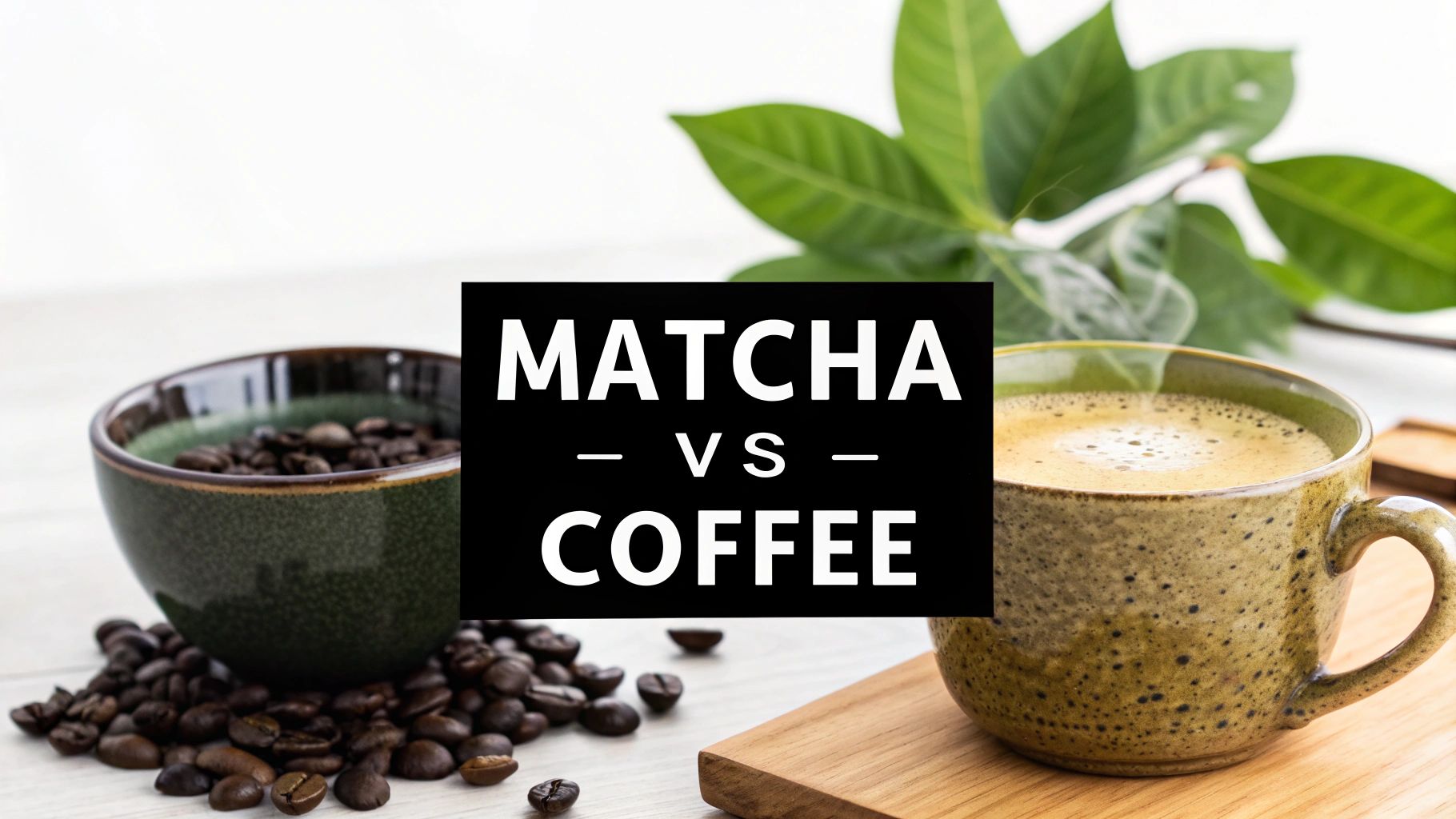
Discover the difference in matcha caffeine content vs coffee. Find out which provides a smoother, longer-lasting energy boost for focus and wellness.
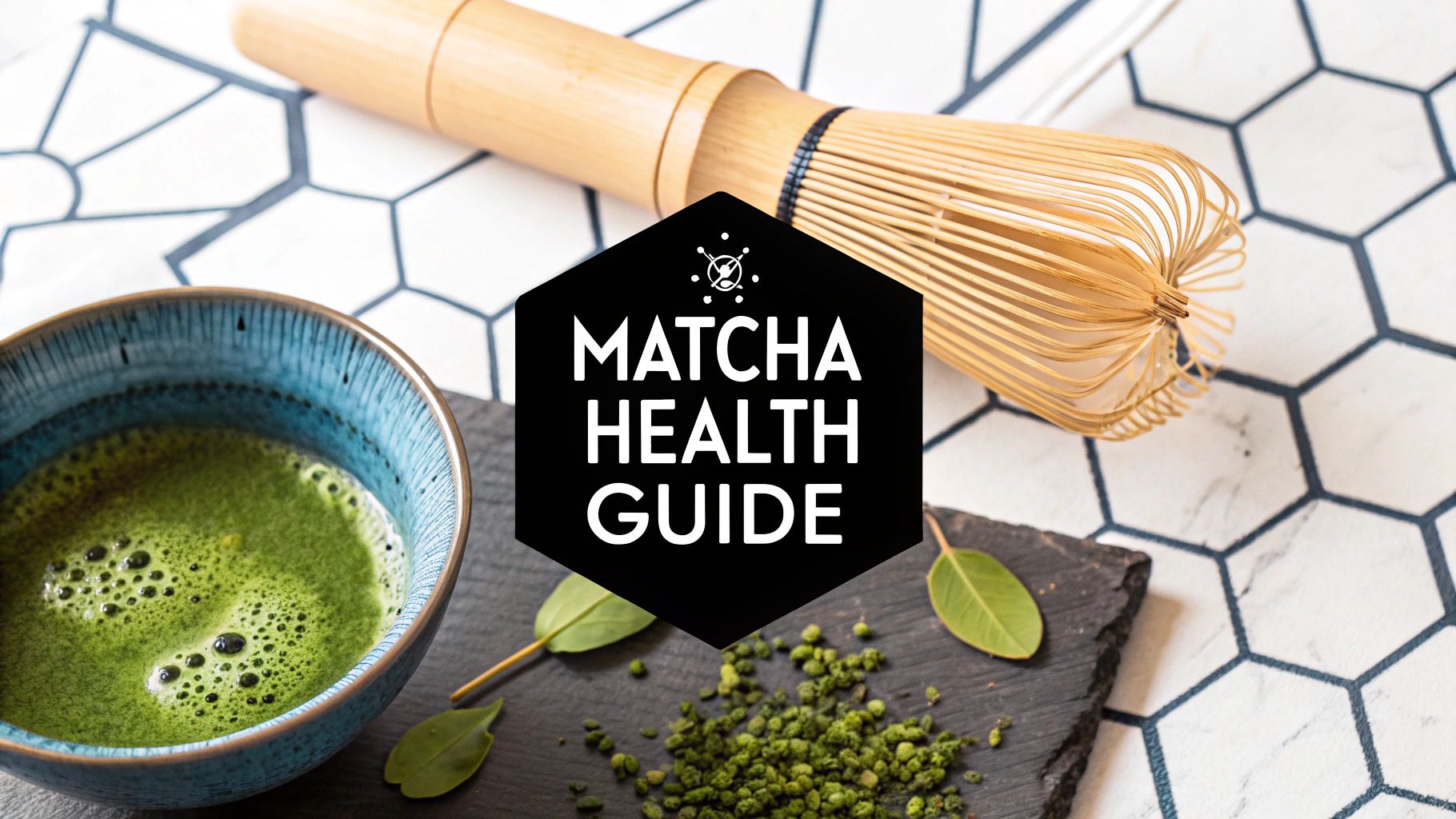
Discover the science-backed matcha health benefits, from calm energy to improved wellness. Learn how matcha can transform your daily health routine.
